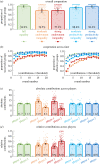Cooperation and coordination in heterogeneous populations
- PMID: 36934745
- PMCID: PMC10024987
- DOI: 10.1098/rstb.2021.0504
Cooperation and coordination in heterogeneous populations
Abstract
One landmark application of evolutionary game theory is the study of social dilemmas. This literature explores why people cooperate even when there are strong incentives to defect. Much of this literature, however, assumes that interactions are symmetric. Individuals are assumed to have the same strategic options and the same potential pay-offs. Yet many interesting questions arise once individuals are allowed to differ. Here, we study asymmetry in simple coordination games. In our set-up, human participants need to decide how much of their endowment to contribute to a public good. If a group's collective contribution reaches a pre-defined threshold, all group members receive a reward. To account for possible asymmetries, individuals either differ in their endowments or their productivities. According to a theoretical equilibrium analysis, such games tend to have many possible solutions. In equilibrium, group members may contribute the same amount, different amounts or nothing at all. According to our behavioural experiment, however, humans favour the equilibrium in which everyone contributes the same proportion of their endowment. We use these experimental results to highlight the non-trivial effects of inequality on cooperation, and we discuss to which extent models of evolutionary game theory can account for these effects. This article is part of the theme issue 'Half a century of evolutionary games: a synthesis of theory, application and future directions'.
Keywords: asymmetric game; cooperation; coordination; evolutionary game theory; inequality; threshold public goods game.
Conflict of interest statement
We declare we have no competing interests.
Figures



References
-
- Smith JM, Price GR. 1973. The logic of animal conflict. Nature 246, 15-18. (10.1038/246015a0) - DOI
-
- Smith JM. 1982. Evolution and the theory of games. Cambridge, UK: Cambridge University Press.
Publication types
MeSH terms
LinkOut - more resources
Full Text Sources
